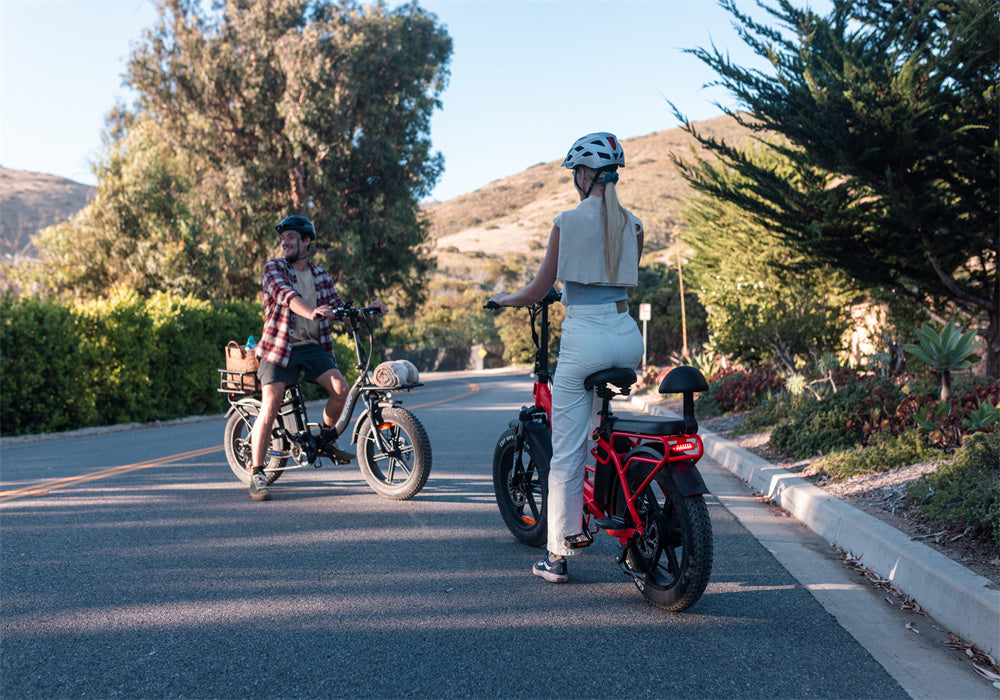What is a Torque Sensor
A torque sensor is an advanced device used in electric bikes to measure the force you apply to the pedals. When you push down on the pedals, the torque sensor detects the amount of force and sends this data to the bike's controller. The controller then adjusts the motor's power output to match your effort, providing a smooth and natural ride. This real-time adjustment makes the bike feel like an extension of your body, offering a more intuitive and enjoyable riding experience. Torque sensors are typically installed in the crank or bottom bracket area and are essential for delivering a seamless, responsive ride that closely mimics the sensation of riding a traditional bicycle.

Which eBikes Have Torque Sensors
Several high-quality electric bicycles come equipped with torque sensors to enhance the riding experience. One notable example is the Tesway X5. This foldable electric bike features a robust 750W motor and a torque sensor, providing a powerful and responsive ride.
The Tesway X5 also boasts a quick three-step folding mechanism, making it highly portable and convenient for urban commuting.
It comes with fat tires, which offer increased stability and traction, ensuring a smooth ride across various terrains. The combination of these features makes the Tesway X5 an excellent choice for riders seeking a versatile and high-performance e-bike.
SEE ALSO : Best Affordable E-bikes of 2024
What are the Advantages and Disadvantages of a Torque Sensor
Advantages
Smooth and Natural Ride
One of the primary advantages of a torque sensor is its ability to deliver a smooth and natural riding experience. By measuring your pedaling force and adjusting the motor output in real-time, the torque sensor ensures that the e-bike responds intuitively to your efforts, making it feel like you’re riding a regular bike with a bit of extra help.
Efficient Power Use
Torque sensors help optimize the power usage of your e-bike. Since the motor only provides assistance when you need it, you can often ride longer on a single charge. This efficient power management can result in extended battery life and longer riding ranges.
Better Control
With a torque sensor, you have better control over your e-bike, especially when navigating varying terrains or steep inclines. The power assistance adjusts precisely to your pedaling effort, making climbs easier and descents smoother, enhancing your overall riding experience.
Disadvantages
Higher Cost
Torque sensors are more complex and sophisticated compared to other types of sensors, which makes them more expensive. This additional cost can be a significant factor for budget-conscious consumers.
Complex Installation and Maintenance
Due to their intricate design, torque sensors can be more challenging to install and maintain. This complexity might require professional installation and periodic maintenance to ensure optimal performance, adding to the overall cost of ownership.
Wear and Tear
As torque sensors are subject to constant mechanical stress, they might experience wear and tear over time. This wear can lead to a decrease in accuracy and reliability, necessitating more frequent replacements or repairs, which can be inconvenient and costly.
What is the Benefit of a Cadence Sensor
A cadence sensor measures the rotational speed of the pedals, or how fast you are pedaling, rather than the amount of force you apply. This sensor works by detecting the number of revolutions per minute (RPM) and provides power assistance based on this data. The primary benefit of a cadence sensor is its simplicity and ease of use. You don’t need to pedal hard to receive assistance; you just need to keep a steady pedaling motion. This feature is particularly advantageous for casual riders or those who prefer a more relaxed riding style, as it allows them to receive consistent power assistance without the need for intense physical effort.
Benefits of Cadence Sensors
Simplicity
Cadence sensors are straightforward to use. They don’t require you to exert a specific amount of force, just maintain a consistent pedaling speed. This makes them ideal for beginners and casual riders who want a hassle-free riding experience.
Affordability
Cadence sensors are generally less expensive than torque sensors. Their simpler design and easier installation process make them a cost-effective option for those looking to enjoy the benefits of an e-bike without breaking the bank.
Ease of Maintenance
Due to their simpler construction, cadence sensors require less maintenance and are easier to service. This can be a significant advantage for riders who prefer low-maintenance solutions.

What are the Disadvantages of Cadence Sensor
Less Natural Ride Feel
One of the main disadvantages of a cadence sensor is that it can result in a less natural riding experience compared to a torque sensor. Since power assistance is provided based on pedal rotations rather than force, the ride may feel more artificial and less responsive.
Less Efficient Power Use
Cadence sensors can be less efficient in terms of power usage. Because they provide assistance based on pedaling speed rather than force, the motor might deliver more power than necessary, potentially leading to quicker battery depletion.
Limited Control
Riders using a cadence sensor might find they have less precise control over their e-bike, especially in challenging riding conditions. The fixed power assistance levels can make it harder to navigate steep hills or uneven terrains smoothly.

Which is Better: Speed or Cadence Sensor
Speed sensors measure the overall speed of the e-bike and provide power assistance accordingly. This method can be beneficial for riders who prioritize maintaining a steady speed, regardless of pedaling intensity. Speed sensors can help maintain a consistent ride pace, making them ideal for long-distance commuting.
Cadence sensors measure pedaling speed and adjust power assistance based on the rider’s pedaling rate. This approach allows for a more dynamic and adaptable riding experience, catering to those who prefer a more interactive engagement with their e-bike. Cadence sensors are typically favored by riders who want a simple and straightforward riding experience without focusing too much on their pedaling force.
The choice between speed and cadence sensors depends on your specific needs and riding habits. Those seeking a more relaxed and steady ride might prefer speed sensors, while those who enjoy a more engaged and responsive ride might opt for cadence sensors.

Is Torque Sensor Better Than Cadence Sensor
The question of whether a torque sensor is better than a cadence sensor hinges on what aspects of the riding experience are most important to you. Torque sensors are generally considered superior in terms of providing a natural and intuitive riding feel. They respond to your pedaling force, offering precise power assistance that enhances the overall experience. This responsiveness makes torque sensors ideal for riders who value a seamless integration of their physical effort with motor assistance.
Cadence sensors offer simplicity and ease of use, making them suitable for casual riders or those who prefer a consistent power output without the need for substantial physical exertion. Cadence sensors are also typically more cost-effective and easier to maintain, which can be significant advantages for some users.
Conclusion
Torque sensors excel in delivering a natural, responsive ride, making them ideal for riders seeking a more engaging and intuitive feel. Cadence sensors, on the other hand, offer simplicity, ease of use, and cost-effectiveness, appealing to those who prioritize a straightforward and consistent ride. Buying your best budget electric bicycle at Tesway! Enjoy your every ride!
FAQs
Why might someone choose a cadence sensor over a torque sensor?
A cadence sensor is more affordable, easier to install and maintain, and ideal for casual riders who prefer consistent power assistance without the need for intense physical effort.
What are the disadvantages of a cadence sensor?
Cadence sensors can feel less natural, be less efficient with power usage, and provide limited control over power assistance, especially on challenging terrains.
Which is better: a speed sensor or a cadence sensor?
The choice depends on your riding preferences. Speed sensors help maintain a consistent ride pace, while cadence sensors offer a more dynamic and interactive experience based on pedaling speed.







Share:
Pedal Assist Electric Bike Explained
Upgrade Your Ride with Power? These powerful converison kits you should know